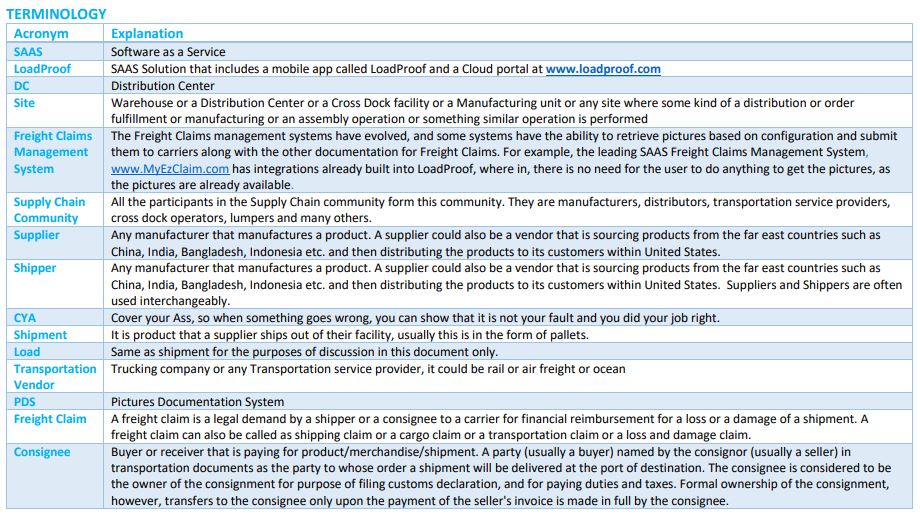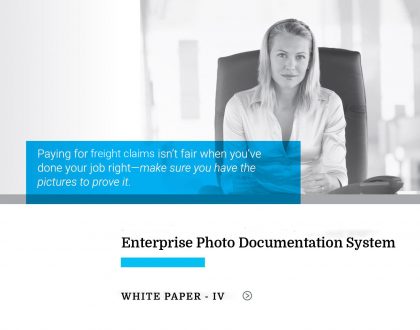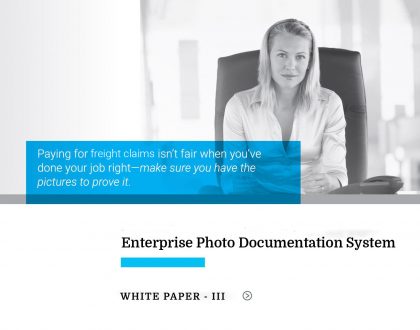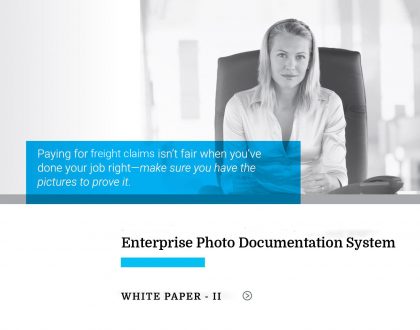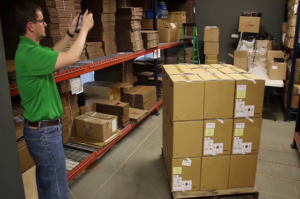Picture Documentation for Freight Claims White Paper – Part III

LoadProof – Enterprise wide Rollout
INTRODUCTION
This document describes the following,
- Provides high level guidelines to deploy Loadproof enterprise-wide involving 2 or more distribution centers producing the most dollar savings for warehouse managers that own the sites.
- Best practices to follow while deploying Loadproof across 2 or more sites in an enterprise-wide fashion.
- Also build momentum within the enterprise among the warehouse general managers, so Loadproof is deployed swiftly producing the maximum dollar savings enterprise-wide quickly.
- Any tool if not implemented correctly and accurately will not produce the desired results. So it is very important that the implementation effort is as great as the tool in order to maximize the gains from the tool such as LoadProof enterprise-wide.
- This document describes the implementation of an effective Picture Documentation system in an enterprise. If you review the “Pictures for Freight Claims – White Paper – Part1” , “Pictures for Freight Claims – White Paper – Part2”and then review this current document, you will get much more value out of this exercise to understand the Picture Documentation System thoroughly. However, it is okay to review this current document by itself as well.
Background
LoadProof is a photo documentation SAAS solution that allows any warehouse manager to develop a catalog of easily searchable photos with contextual data that helps warehouses, manufacturers, shippers and suppliers reduce claims, chargebacks and also get Freight Claims processed faster. While it is a much simple project to turn on Loadproof for one or two sites, whereas rolling out LoadProof in a larger enterprise involving 2 or more sites is a different ball game that needs to be approached differently with appropriate sponsorship and evangelizing for a broader acceptance realizing the most cost savings for the whole enterprise.
Establish a LoadProof Deployment Project
1. It is important to establish a LoadProof deployment project with a dedicated project manager within your Enterprise to successfully carry out the deployment of the LoadProof tool in all your sites.
2. And this project manager gets all the resources, staffing, support, sponsorship and everything else like all other projects that are executed within the enterprise
3. And this project manager is held accountable for LoadProof deployment in all the sites within the enterprise and the associated cost savings that the Loadproof tool provides.
4. And this project is managed, monitored and executed like any other project within the enterprise with weekly status calls and other associated activities.
5. The Project Manager provides a clear project plan for the rollout and executes to that plan like any other project following the project execution methodologies publishing appropriate status reports to the key stake holders, site managers, project sponsors, steering committee etc.
Establish an Internal LoadProof Champion for your Enterprise
This person is the internal LoadProof expert for the enterprise. This person understands the business of the organization at a site level and is able to do the following effectively
- Provide general guidance to use the tool effectively from the perspective of the end user.
- Be an internal expert that is not only fully knowledgeable on the LoadProof tool but also the business of the enterprise and able to blend both to provide the most fitting assistance to different sites, different use cases, different product lines etc.
- Help the end users determine the appropriate set of contextual data that needs to be captured keeping their business challenges in mind.
- Apply the lessons learnt from LoadProof implementation in one site into the successive sites that implement Loadproof.
- Serve as a liaison between the Enterprise and the Loadproof team at Smart Gladiator.
Add LoadProof Deployment to your current Enterprise processes
- Most 3PLs are constantly starting up new sites and constantly shutting down old sites. Add LoadProof to the check list of the Project Managers that manage the site startups and also the site shutdowns.
- Most 3PLs have teams of industrial engineers that are continuously monitoring the sites to identify opportunities for improvement. Add Loadproof to the list of opportunities for such industrial engineering teams to check while they are performing their GEMBA walks.
- Most 3PLs have six sigma practitioners that are validating processes on a regular basis. Add Loadproof to the list of those six sigma practitioners hence they can add LoadProof also to their tool kit.
- LoadProof has become an attractive sales tool for 3PL companies. So include LoadProof to the technology stack that you provide to your customers in order to facilitate greater transparency in the way you operate and also the emphasize the fact that your customers can get better Supply Chain visibility now, as they can look at pictures of their merchandise in specific scenarios.
- Include LoadProof deployment and associated savings in the performance appraisal for site General Managers and key stake holders.
- How does your enterprise communicate? How do you normally disseminate this info? Spread info about Loadproof through all those channels.
- Educate your Account Managers about LoadProof, so they can pass on the benefits with LoadProof to their existing accounts.
- Also communicate within the sites within the accounts. For example, there might Site1 and Site2 using LoadProof, whereas let us say there are Also Sites 3 and 4 servicing the same OEM, then communicate the savings from Site1 and Site2 to Site3 and Site4 also, so Site3 and 4 realize the benefits as well.
Selecting the First Few Sites
It is very important to select the first few sites very carefully. As the success from these sites set the tone for the rest of the sites to adapt this solution in a much broader fashion. Identify sites with the following attributes
- Sites with the most savings due to chargebacks and/or Freight and or damage claims.
- Sites where the users are motivated to use LoadProof.
- Sites where the users have the skillset to use the tool.
- Sites that are low hanging fruits.
- Sites with General Managers that are progressive and forward thinking that embrace innovation and new ideas.
- Sites that adapt to changes fast.
Deployment in the first site
It is very important to get this first deployment right, so everybody in the org sees the gains, sees the opportunity, sees that not only they can add value to the org, but also in the process can get some gains for themselves. It is very important to make sure that alignment is there between the project leader’s goals that is heading this first deployment and the org’s goals. There are a lot of things that need to be done right, in order to get the first deployment a huge success. For example in one of the pilots our customers did, the leader that was setting up the tool created this user id that is 20 bytes long, after starting to test the tool, he came back to us saying that the users did not like the tool, when we dug into that further, the reason users did not like it because it was cumbersome to enter the 20 byte user name to login in a small mobile device. This leader set up this tool in a hurry without much of a thought about how the user is going to enter the user id in the small mobile device. Then we changed the username to 10 byes or less, then the users liked the tool very much and starting adapting the tool. Also it is very important to celebrate the small wins, because you are introducing a change and the org is adapting to that change, it is very important to encourage that change that is occurring.
What is the Culture in your Enterprise?
Some enterprises are driven top down culturally, the top leadership team determines the priorities, sets the objectives, then they find their trusted lieutenants, they delegate to the lieutenants with appropriate sponsorship, these lieutenants or Project Managers, now with the blessing, work through the enterprise bureaucracy, do whatever it takes and get the projects completed. Whereas some enterprises are driven by the end users that tell their managers about the best tools they like and also share ideas to do their jobs better, which gets communicated all the way to the executive management through proper channel, then the executives give their blessing, then such projects are executed successfully in a cohesive manner by both the middle managers and the end users. The benefits of the bottom up approach is that, it is much easier to get the buy in from the end users and hence for them to adapt, as they have not only used the tool, played with the tool multiple times, they also get to see the benefits and the implications the tool has in their daily life while they perform their respective roles. Most importantly here with LoadProof, the tool enables them to prove that as end users that they did their job right. Some enterprises might follow a blend of both top down and bottoms up approach. Whereas in the top down approach, with the strong blessing from the executive management, it is much easier to push through the initiative and work through by accommodating adjustments to the impediments that may come in the way. So pick a strategy that works for your enterprise based on the culture that prevails in your enterprise.
Change Management – Change is Hard
Change management and innovation go hand in hand. It is comparatively easy to innovate but getting the entire enterprise to adopt that change is trickier, even though we all know that change is the only thing that is constant. In an area like supply chain, where conformity is favored over individuality, it gets even more challenging.
There are many reasons for it, including
- Not everybody likes to change when they are comfortable with the status quo.
- People are territorial, nobody wants to lose their territory.
- Organizational inertia makes it much easier to do things the old way.
- Embracing the “if it ain’t broken, don’t fix it” mentality.
- People in general are risk averse, nobody wants to risk what they have and where they have gotten in their career.
So the critical task is not just innovating, but also fostering that innovation in a way that gains adoption. Without buy-in, it’s simply too easy to abandon a truly great and innovative idea.
Change Management – Empathy for End Users
A distribution center is a very busy place. And it is very common to measure the users’ activity using a labor management system in order to ensure not only the users are performing, but also pro-actively asking for work if they are out of one. So that the culture of being the most productive is celebrated resulting in high throughput and most revenue for the enterprise. So, it is important to realize that asking users to use a new tool is going to slow them down and could potentially impact their incentives. So, it is very important to educate them that they are not going to be penalized if there is a slight dip in their KPI, while this new tool LoadProof is being deployed. Also, from the management perspective, empathize with them and give them some time to adapt to the new tool. Also provide assistance following a train the trainer model.
Change Management – Feedback from End Users on a Regular basis
Any innovation needs fostering to make sure it is a one hundred percent success. That work can be done only by working closely with the end users, listening to their feedback and incorporating their suggestions. In an enterprise-wide rollout, it’s critical to have structure and process in place to get feedback from end users to support innovation and ensure proper change management to allow input to be incorporated. Without help, adoption can get stuck. This can take many forms, from a suggestion box or web site that collects feedback to longer user-input sessions.
Celebrate Small Wins
The power of progress is fundamental to human nature and hence it is important to leverage that to boost motivation in your enterprise, as part of this project. Share any progress that has been made and share any improvements, even though they may be small. Also identify catalysts, actions that directly support the project, including help from a person or group, and nourishers, events such as shows of respect and words of encouragement. When we think about progress, we often imagine how good it feels to achieve a long-term goal or experience a major breakthrough. These big wins are great, but they take a while time to accomplish. The good news is that even small wins can boost the project success tremendously and eventually the small wins lead to big successes.
Evangelizing LoadProof Enterprise-wide
One of the key activities that need to happen enterprise-wide is everyone needs to know about LoadProof. Following are some of the ways to get the word out about LoadProof Enterprise-wide.
- Prepare a one pager on LoadProof and forward that as part of the company newsletter.
- Also add that one pager to the internal company website.
- Also add that one pager to the internal website of the Engineering and or innovation team
- Write blog posts about LoadProof success in your sites.
- Get video testimonials and post them in your internal websites like we have done here – https://loadproof.com/features
- Share success stories from Loadproof deployments – if they can do it you can do it too??
- Make LoadProof training videos and make them available such that the Warehouse Managers and end users can watch these videos and learn from them at their own convenience.
- If there is an exclusive Email distribution list for General Managers, include LoadProof in those emails too.
- If there is an exclusive Email distribution list for Vice Presidents, include LoadProof in those emails too.
Establish a Steering Committee
A steering committee does 2 things at a high level,
- Provides Strategic Direction.
- Supports the Project and the Project Manager.
A Steering Committee typically comprises senior managers who have a vested interest in the delivery and/or outcome of the project. Steering committee could also potentially provide updates to the upper management, sponsors and all the way to the C level and sometimes even to the board.
With a steering committee established, it is much easier to get the attention of the Executive level management if the project runs into any trouble. The steering committee is optional & Steering committee could meet once a quarter.



